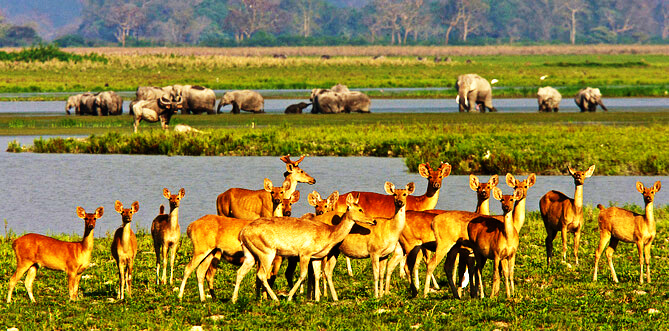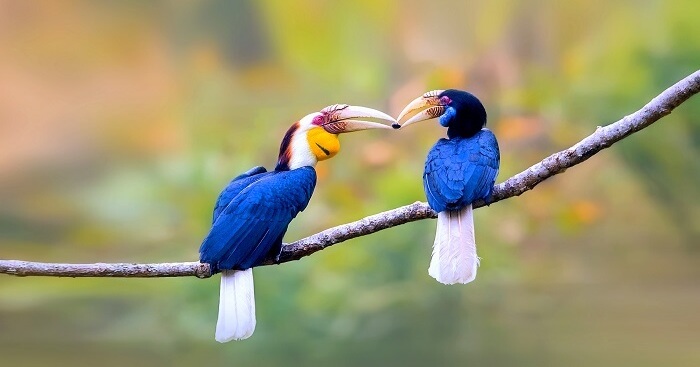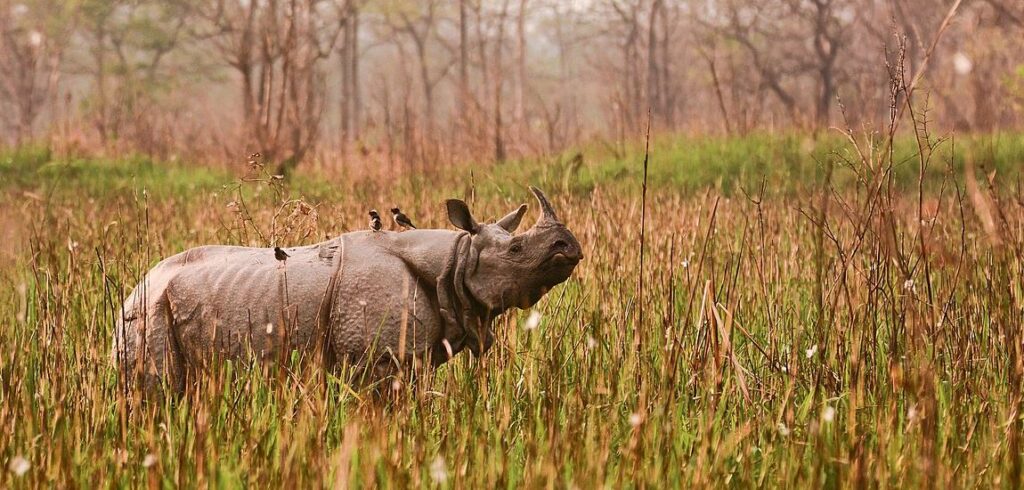Kaziranga National Park, located in the state of Assam, India, is a haven for wildlife enthusiasts. This protected area is famous for its rich biodiversity and is home to numerous endangered species. Established in 1905, Kaziranga National Park covers an area of 430 square kilometers and attracts visitors from around the world. Its unique landscape features tall elephant grass, marshland, and dense forests, providing a diverse habitat for a wide range of wildlife. So, if you’re passionate about wildlife, Kaziranga National Park should be at the top of your travel list.
History and significance of Kaziranga National Park
Kaziranga National Park has a rich history and holds immense significance in the conservation of wildlife. It was established in 1905 as a response to the alarming decline of the Indian one-horned rhinoceros population. Today, it is recognized as a UNESCO World Heritage Site and plays a crucial role in the preservation of various endangered species. The park’s historical importance lies in its successful efforts to protect and revive populations of iconic wildlife species, making it a valuable testament to conservation efforts.
Geographical location and biodiversity of Kaziranga National Park

Kaziranga National Park is located in the northeastern state of Assam, India. It covers an area of about 430 square kilometers and is situated on the southern banks of the Brahmaputra River. The park’s unique geographical location, with its diverse habitats including grasslands, wetlands, and woodlands, supports a rich biodiversity. It is home to more than 2,200 Indian one-horned rhinoceros, as well as significant populations of other iconic species such as tigers, elephants, and water buffaloes. The park’s diverse flora and fauna make it a hotspot for nature enthusiasts and researchers alike.
Wildlife Species in Kaziranga National Park

Kaziranga National Park is renowned for its diverse wildlife species, making it a paradise for wildlife enthusiasts. The park is home to the majestic Indian one-horned rhinoceros, with a population of over 2,200 individuals. Other notable species include Bengal tigers, elephants, and water buffaloes. Kaziranga’s rich biodiversity also includes various bird species, making it a haven for birdwatchers. Visitors can embark on thrilling elephant and jeep safaris to catch glimpses of these magnificent creatures in their natural habitat. The park’s conservation efforts are vital for preserving these endangered species and their habitats.
One-horned rhinoceros and its conservation status
The one-horned rhinoceros is a prominent species in Kaziranga National Park, with a thriving population of over 2,200 individuals. These majestic creatures are listed as vulnerable by the IUCN due to habitat loss and poaching. Conservation efforts in the park, including anti-poaching patrols and habitat restoration, have played a crucial role in safeguarding the rhinoceros population. Strict protection measures and community involvement have helped stabilize their numbers, making Kaziranga National Park a vital stronghold for the conservation of this iconic species.
Bengal tigers and other big cat populations in the park
Bengal tigers and other big cat populations thrive in Kaziranga National Park, making it a haven for wildlife enthusiasts. With over 100 tigers, the park is an important habitat for this endangered species. Other big cats such as leopards and clouded leopards also call the park home. These magnificent predators play a crucial role in maintaining the balance of the ecosystem. Spotting these elusive creatures during safari experiences in the park is a thrilling and unforgettable experience for visitors.
Bird Watching in Kaziranga National Park

Notable bird species like Great Indian hornbill, Bengal florican, and Asian openbill storks make Kaziranga National Park a paradise for birdwatchers. With over 500 bird species recorded, the park offers abundant opportunities for birdwatching. Visitors can embark on guided birdwatching tours or explore the park’s numerous trails and watchtowers to spot a variety of avian species. Early morning and late afternoon are the best times for birdwatching, when many birds are active. Don’t forget to bring your binoculars and camera to capture these beautiful feathered creatures in their natural habitat.
Notable bird species and bird-watching opportunities
Notable bird species like Great Indian hornbill, Bengal florican, and Asian openbill storks make Kaziranga National Park a paradise for birdwatchers. With over 500 bird species recorded, the park offers abundant opportunities for birdwatching. Visitors can embark on guided birdwatching tours or explore the park’s numerous trails and watchtowers to spot a variety of avian species. Early morning and late afternoon are the best times for birdwatching, when many birds are active. Don’t forget to bring your binoculars and camera to capture these beautiful feathered creatures in their natural habitat.
Importance of Kaziranga National Park for bird conservation
Kaziranga National Park holds immense importance for bird conservation due to its diverse avian species and habitat preservation efforts. The park provides a safe haven for endangered and migratory birds, contributing to their survival and population growth. Conservation initiatives like anti-poaching measures, habitat restoration, and awareness campaigns further enhance the park’s role in protecting these feathered creatures. By visiting Kaziranga National Park, wildlife enthusiasts can support bird conservation efforts and witness the beauty of these magnificent birds in their natural environment.
Safari and Activities in Kaziranga National Park
Elephant safaris and jeep safaris in Kaziranga National Park offer thrilling experiences to observe wildlife up close. Riding on the back of an elephant or cruising through the park in a jeep, you can witness the majestic one-horned rhinoceros, spot elusive Bengal tigers, and admire the diverse bird species. These safari adventures provide a unique opportunity to explore the park’s vast grasslands, wetlands, and forests while ensuring minimal disturbance to the wildlife. Engage in these activities for an unforgettable wildlife encounter in Kaziranga National Park.
Elephant safaris and jeep safaris in the park
Experience the thrill of exploring Kaziranga National Park through elephant safaris and jeep safaris, providing you with an up-close encounter with the wildlife. Hop on the back of an elephant or venture into the park in a jeep to witness the majestic one-horned rhinoceros, spot elusive Bengal tigers, and marvel at the diverse bird species. These safari adventures offer a unique opportunity to traverse the park’s grasslands, wetlands, and forests while ensuring minimal disturbance to the wildlife. Engage in these activities for an unforgettable wildlife experience in Kaziranga National Park.
Community-based ecotourism initiatives in Kaziranga National Park
Community-based ecotourism initiatives in Kaziranga National Park offer visitors a chance to contribute to conservation efforts while enjoying the park’s natural beauty. These initiatives involve local communities in sustainable tourism activities like guided nature walks, handicraft workshops, and cultural performances. By participating in these experiences, visitors not only support the livelihoods of local residents but also gain a deeper understanding of the park’s ecosystems and the importance of conservation. Engage in community-based ecotourism initiatives to make a positive impact and create lasting memories in Kaziranga National Park.
Challenges and Conservation Efforts in Kaziranga National Park

Challenges in Kaziranga National Park include human-wildlife conflict and poaching, posing threats to the park’s biodiversity and conservation efforts. To address these challenges, various conservation programs and initiatives have been implemented. These include anti-poaching patrols, habitat restoration projects, and community engagement programs to promote sustainable livelihoods. Through these efforts, Kaziranga National Park aims to protect its wildlife and ensure the long-term survival of endangered species. Conservation awareness among visitors is crucial in supporting these initiatives and contributing to the preservation of this remarkable ecosystem.
Human-wildlife conflict and poaching issues
Human-wildlife conflict and poaching pose significant challenges to the conservation efforts in Kaziranga National Park. To mitigate these issues, the park has implemented measures such as anti-poaching patrols and the establishment of community engagement programs to promote sustainable livelihoods. These initiatives aim to protect the park’s biodiversity and ensure the long-term survival of endangered species. By addressing human-wildlife conflict and combating the illegal wildlife trade, Kaziranga National Park strives to create a safe haven for wildlife enthusiasts and preserve its remarkable ecosystem.
Conservation programs and initiatives in Kaziranga National Park
To address the conservation challenges in Kaziranga National Park, several programs and initiatives have been implemented. These include anti-poaching patrols to combat illegal wildlife trade, community engagement programs to promote sustainable livelihoods, and habitat restoration projects. These efforts aim to protect the park’s biodiversity and ensure the long-term survival of endangered species. By taking proactive measures, Kaziranga National Park strives to create a safe haven for wildlife enthusiasts and preserve its remarkable ecosystem.
Visitor Information and Conclusion

Visitor Information and Conclusion:
When planning your visit to Kaziranga National Park, it’s important to follow the visitor guidelines provided by park authorities. The best time to visit is from November to April when the park is open to tourists. Make sure to book your safari in advance, whether it’s an elephant safari or a jeep safari, as they offer different experiences. When visiting, remember to respect the park’s wildlife and ecosystem by not littering and maintaining a safe distance from the animals. Kaziranga National Park offers an incredible experience for wildlife enthusiasts, allowing you to witness the beauty of nature and contribute to its conservation. Don’t miss out on this must-visit destination!
Visitor guidelines and best time to visit Kaziranga National Park
Visitor guidelines for Kaziranga National Park include respecting the park’s wildlife and ecosystem, not littering, and maintaining a safe distance from animals. The best time to visit is from November to April when the park is open to tourists. During this period, you can book either an elephant safari or a jeep safari to explore the park’s diverse wildlife. It is recommended to plan your visit in advance and make necessary bookings for a memorable experience. Remember, by following these guidelines, you contribute to the conservation efforts of this remarkable national park.
Summary of why Kaziranga is a must-visit for wildlife enthusiasts

Kaziranga National Park is a must-visit for wildlife enthusiasts due to its rich biodiversity and conservation efforts. The park offers a chance to witness rare species like the one-horned rhinoceros and Bengal tigers in their natural habitat. Bird watchers can delight in the diverse avian species found here. The park provides thrilling safari experiences, including elephant safaris and jeep safaris, allowing visitors to get up close to the wildlife. By visiting Kaziranga, you not only have the opportunity to appreciate its natural beauty but also contribute to its preservation.
For More Blogs visit Hillw
